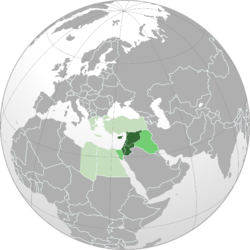Masyrik
From Wikipedia, the free encyclopedia
Remove ads
Masyrik (AFA: [mɑʃ·rik]; Jawi: مشرق), juga dipanggil Levant ialah sebuah kawasan yang besar di rantau Mediterranean Timur Asia Barat dan nama yang digunakan untuk bidang sejarah. Dalam arkeologi dan konteks budaya, ia merangkumi Cyprus dan pesisiran Mediterranean di Asia barat,[4][5] iaitu wilayah Syam dahulu, yang merangkumi Israel, Jordan, Lubnan, Syria, Palestin dan sebahagian besar Turki barat daya Furat tengah Ciri yang mengagumkan ialah ia mewakili jambatan darat antara Afrika dan Eurasia . [5] Dalam pemahaman sejarah pula, Masyrik merangkumi seluruh Mediterranean Timur dengan pulau-pulaunya,[6] menjangkau semua negara di sepanjang pantai Mediterranean Timur, dari Yunani di Eropah Selatan hingga Barqah, Libya Timur di Afrika Utara.[7]
Pada abad ke-13 dan ke-14, perkataan levante digunakan untuk perdagangan maritim Itali di Mediterranean Timur, termasuk Yunani, Anatolia, Syam dan Mesir—tanah di timur Venice. Akhirnya ia hanya digunakan untuk negara-negara Islam Syam dan Mesir. Perkataan itu memasuki bahasa Inggeris pada akhir abad ke-15 melalui Perancis.[6] Ia berasal daripada bahasa Itali, levante, yang bermaksud "terbit" yakni timur di mana tempat matahari terbit, dan setara dengan perkataan al-Mashriq (Arab: ٱلْمَشْرِق, [ʔal.maʃ.riq]),[8] bermaksud "tempat timur, tempat matahari terbit".[9]
Pada tahun 1581, England memulakan Syarikat Levant untuk berdagang dengan Empayar Usmaniyah. Nama Negeri-negeri Levant digunakan bagi mandat Perancis untuk Syria dan Lubnan selepas Perang Dunia I. Ini mungkin sebab mengapa Levant biasa digunakan untuk Syria moden, Lubnan, Palestin, Israel, Jordan, dan Cyprus. Sesetengah sarjana tersilap percaya bahawa ia berasal dari nama Lubnan. Kini perkataan itu sering digunakan berkaitan dengan sejarah purba. Ia mempunyai makna yang sama dengan "Syria-Palestin" atau Syam (Arab: ٱلشَّام, /ʔaʃ.ʃaːm/), kawasan yang dibatasi oleh Pergunungan Taurus Turki di utara, Laut Mediterranean di barat, Gurun Arab utara dan Mesopotamia di timur, dan Sinai di selatan.[10][5] Biasanya Anatolia (juga dipanggil Asia Minor), Pergunungan Caucasus, atau mana-mana bahagian Semenanjung Arab tidak termasuk. Cilicia (di Asia Minor) dan Semenanjung Sinai (Asia Mesir) kadangkala disertakan.
Sesetengah kamus menganggap Masyrik istilah yang lapuk.[11][12][13] Ia nama dan adjektif bagi kawasan di mana budaya kuno dan moden seperti Syam atau Palestin berasal. Contohnya, ahli arkeologi kini bercakap tentang Masyrik dan arkeologi Levantin; [14][15][16] pakar makanan bercakap tentang masakan Levant; [4] dan orang Kristian Latin di Levant masih dipanggil Kristian Levant.[17]
Levant pernah dipanggil "persimpangan Asia Barat, Mediterranean Timur, dan Afrika Timur Laut",[18] dan dalam bidang geologi (tektonik) adalah "barat laut Plat Arab".[19] Penduduk Masyrik[20][21] berkongsi bukan sahaja kedudukan dalam geografi, tetapi masakan, beberapa adat, dan sejarah. Mereka sering dipanggil orang Levant.[22]
Remove ads
Lihat juga
Penamaan wilayah yang bertindih
Lain-lain
- Negara Islam Iraq dan Levant (Dirujuk dalam peristiwa semasa sebagai ISIL atau ISIS)
- Laut Syam
- Orang Levantin (Kristian Latin), orang Eropah Katolik di Masyrik
Nota penerangan
- Jumlah penduduk dengan menambahkan populasi Cyprus, Israel, Jordan, Lubnan, Palestin, [ [Syria]], Turki Wilayah Hatay dan
 Republik Turki Cyprus Utara (Tidak Diiktiraf).
Republik Turki Cyprus Utara (Tidak Diiktiraf).
Petikan
Rujukan umum dan yang dipetik
Bacaan lanjut
Pautan luar
Wikiwand - on
Seamless Wikipedia browsing. On steroids.
Remove ads

